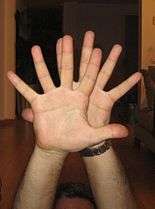Obscene gesture
An obscene gesture is a movement or position of the body, especially of the hands or arms, that is considered exceedingly offensive or vulgar in some particular cultures. Such gestures are often sexually suggestive.
The Finger

Although "the finger" has been called "the universal sign of disrespect",[1] it is not truly universal. For example, in Japanese Sign Language, when the palm is facing out, it is recognized as the character せ ("se"). Many other gestures are used in addition to, or in lieu of, the finger in various parts of the world to express the same sentiment. In some parts of the world, "the finger" does not have any meaning at all.
In India, Pakistan, and Sri Lanka the social circles exposed to the western cultures use the middle finger gesture in the same sense that it is used in those cultures. The same is true for most South Asian countries.
In Portugal this gesture is also called by "Pirete".
V Sign

In the Commonwealth of Nations countries (except Canada), the V sign as an insult (the middle and index fingers raised, and given with back of the hand towards the recipient) serves a similar purpose to The finger. The V sign with palm faced outwards is a sign of peace.
Bras d'honneur
In countries where Spanish, Portuguese, or French are spoken, and especially on the Iberian peninsula and in some parts of Latin America, a gesture called the Bras d'honneur (banana in Brazil) involving raising a fist and slapping the biceps on the same arm as the fist used, sometimes called the Iberian slap or Iberian finger (In Portugal it is called a "Manguito"), is equivalent to the finger. Italy, Poland, and countries under the influence of East Slavic culture (Russia, Belarus, Ukraine) also see the Bras d'honneur as equivalent to the finger. In Guatemala, a gesture equivalent to "the finger" is made by "throwing the hand" forward, digits wide spread, thumb up, pinky down, palm to the left if action is made with right hand (conversely for left hand). This is similar in orientation to the way one would extend for a friendly hand shake, except the arm-wrist-finger assembly is straight, rigid and fully extended in the direction of the target individual.
Dulya

More commonly in Russian-influenced areas, the dulya (also known as fig sign or shysh). This gesture is most commonly used to refuse giving of aid or to disagree with the target of gesture. Usually it is connected with requests for a financial loan or assistance with performing physical work. The gesture is typically made with the hand and fingers curled and the thumb thrust between the middle and index fingers. This gesture is also used similarly in Indonesia, Turkey, China, and Mongolia.
Moutza


In Greece, the five fingers are spread wide and the palm is pushed towards someone in a gesture known as the Moutza. The middle finger is still used though, and it is considered more insulting. Another variation of the middle finger is used, where all the fingers but the middle one are spread wide while moving the hand back and forth in the axis the middle finger creates. In this gesture, the thumb sometimes touches the middle finger. The insult of this is equivalent to the finger.
In Iranian culture, a similar gesture is used to represent "Dirt on your head", a verbal insult that is often used, suggesting the death and subsequent burial of the receiver.
In some African and Caribbean countries, a similarly obscene gesture is extending all five digits with the palm facing forward, meaning "you have five fathers" (thus calling someone a bastard).[2]
Thumbs Up

In former Persia, mainly Iran and Iraq, a gesture involving exposing only the thumb in a vertical orientation—a thumbs up—is used instead of the finger to express roughly the same sentiment. [3]
In some Arab countries, especially Egypt, the middle finger is lowered towards the palm and pointed towards someone, while all other fingers are kept straight. It could be considered the opposite movement of the tradition middle finger gesture, but it serves the same purpose and meaning.
In William Shakespeare's play Romeo and Juliet, Capulet's servant Sampson starts a fight by "biting his thumb" at Abram, Montague's servant. This gesture can be interpreted as being equivalent to giving someone the middle finger.
References
- ↑ E.g., Echard v. Kraft, 159 Md. App. 110, 115; 858 A.2d 1018, 1021 (2004).
- ↑ "What's A-O.K. in the U.S.A. Is Lewd and Worthless Beyond". The New York Times. August 18, 1996. Retrieved 2008-04-11.
- ↑ Roger E. Axtell. Gestures: The Do's and Taboos of Body Language Around the World.